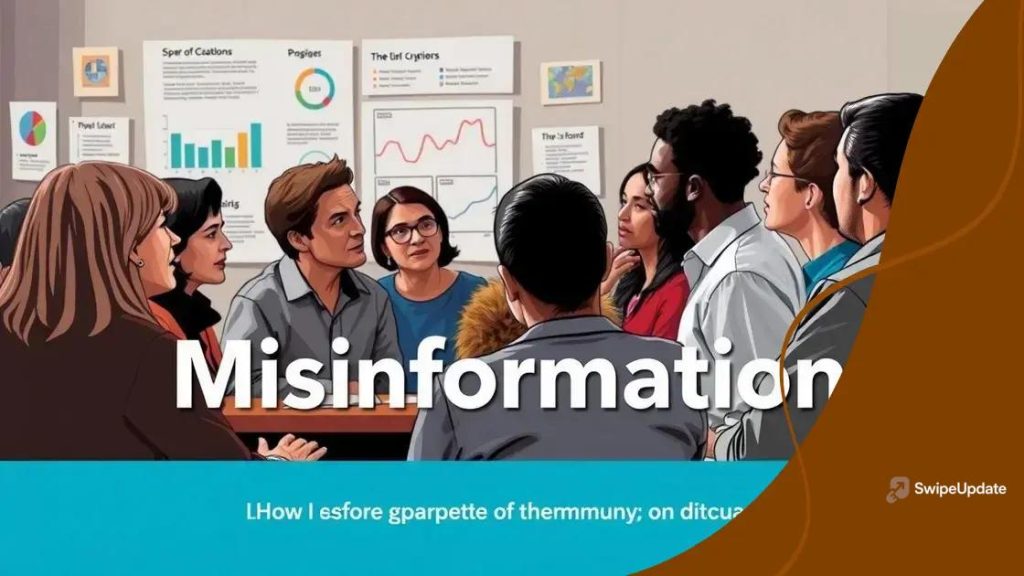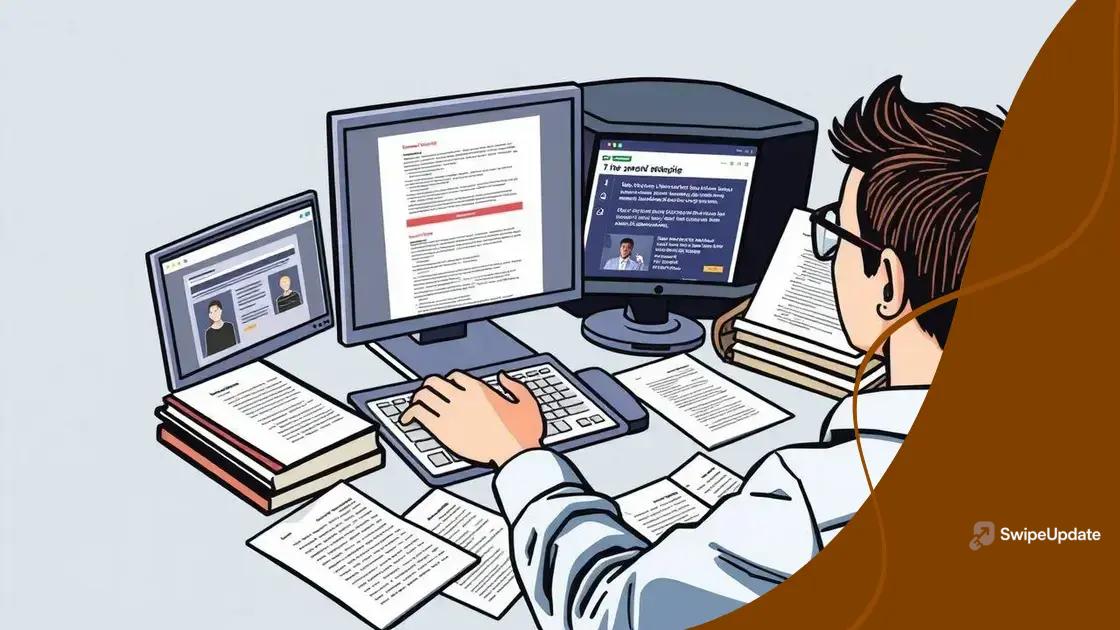Efforts to combat misinformation: how we can make a difference

Efforts to combat misinformation involve verifying information, promoting media literacy, and engaging communities in discussions to identify and counter false narratives effectively.
Efforts to combat misinformation are more important than ever as we navigate a world saturated with information. With so much content at our fingertips, it’s easy to get lost. Are you equipped to separate fact from fiction? Let’s delve into how we can tackle this challenge.
Understanding the impact of misinformation
Understanding the impact of misinformation is vital in today’s digital world. Every day, numerous stories inundate our feeds, often blurring the lines between fact and fiction. This confusion can lead to serious consequences in society and personal beliefs.
Misinformation can skew our perceptions regarding critical topics such as health, politics, and social issues. It spreads rapidly, especially through social media platforms, making it essential to understand its effects.
Effects on Public Perception
The way we view various societal issues can drastically change due to misinformation. For example, false information about health can lead individuals to make poor choices. Moreover, political misinformation can create divisions among communities, causing distrust and conflict.
Personal Impact
Misinformation can also have a profound impact on decision-making. People may find themselves struggling to trust information from credible sources, as they are bombarded with conflicting narratives.
- Increased anxiety over health choices.
- Difficulty distinguishing credible news from falsehoods.
- Polarization of social and political beliefs.
It is crucial for individuals to recognize these effects to mitigate the damage caused by misinformation. Developing critical thinking skills and fostering healthy skepticism can empower us to combat false narratives. Engaging in open conversations about these topics is equally important.
By understanding the impact of misinformation, we can work collectively to promote accuracy and truth in the conversations we have, enabling a healthier discourse in society.
Identifying common types of misinformation
Identifying common types of misinformation is crucial in navigating today’s information landscape. Misinformation can take many forms, often leading to confusion and misunderstanding. By recognizing these types, we can better protect ourselves and others from false narratives.
One prevalent type of misinformation is fake news, which presents fabricated stories as if they were true. This can influence public opinion and cause distress in society. Another common form is hoaxes, where false claims are intentionally spread to deceive people.
Common Types of Misinformation
There are several types of misinformation that we frequently encounter:
- Deliberate misinformation: intentionally created to mislead.
- Outdated information: sharing old data that no longer applies.
- Misleading headlines: titles that exaggerate or distort facts.
Additionally, conspiracy theories can propagate misinformation by connecting unrelated events with unfounded claims. This can influence how people perceive global events, leading to mistrust in legitimate sources.
Another element to consider is satire and parody, which, while often humorous, can be misinterpreted as genuine news. It’s essential to differentiate between satire and real information to avoid falling for misleading content.
The ability to identify these common types of misinformation can significantly reduce its impact on our beliefs and actions. By engaging critically with the content we encounter, we can foster a more informed society.
Strategies to verify information

Strategies to verify information are essential in today’s fast-paced digital world, where misinformation spreads rapidly. Being able to discern fact from fiction allows individuals to make informed decisions. Here are some practical strategies that can help.
Double-Check Sources
One of the most effective ways to verify information is by checking its source. Reliable sources typically have a strong reputation for accuracy. Look for news articles from established organizations or websites that provide factual information.
- Check if the website has a clear about us page.
- Look for contact information indicating legitimacy.
- Research the author’s credentials to ensure credibility.
Another strategy is to cross-check the information against multiple credible sources. If various reputable outlets report the same facts, the information is more likely to be trustworthy.
Examine the Evidence
When evaluating information, scrutinizing the evidence provided is crucial. Reliable articles often back their claims with data, studies, or expert opinions. Look for:
- Links to original research.
- Citations from experts in the field.
- Data from government or academic institutions.
Awareness of common biases also plays a role in verifying information. Be mindful of emotional language and sensationalist headlines, as these are often red flags for misleading information.
Finally, utilizing fact-checking websites can be incredibly helpful. Websites like Snopes and FactCheck.org specialize in debunking false claims and offer a valuable resource for verifying the information you encounter online.
The role of social media in misinformation
The role of social media in misinformation is significant and often alarming. Platforms like Facebook, Twitter, and Instagram enable information to spread rapidly, sometimes without verification. This can lead to false narratives captivating unsuspecting users.
Social media allows anyone to share information, which means that even unverified stories can gain traction quickly. A single post can reach thousands within minutes, making it imperative to understand how these platforms impact our perceptions. The nature of social media promotes sharing, which can amplify misinformation.
How Misinformation Spreads
Several factors contribute to the rapid spread of misinformation on social media:
- Virality: Engaging content, whether true or false, tends to be shared widely.
- Algorithms: Social media algorithms often prioritize content that generates high engagement, which can include sensational or misleading posts.
- Echo chambers: Users often follow like-minded individuals, intensifying the spread of similar misinformation.
Furthermore, the emotional nature of many posts encourages sharing. Content that sparks anger, fear, or laughter can go viral, overshadowing factual information. In light of this, it becomes crucial for users to approach social media with a critical eye.
Combating Misinformation on Social Media
Combating misinformation requires proactive engagement from users. Here are some strategies:
- Check the source before sharing.
- Look for fact-checking labels or alerts on posts.
- Engage in discussions that promote accurate information.
Understanding the role of social media in misinformation aids individuals in navigating this complex landscape. By recognizing how information spreads, users can become more discerning consumers of news and information online.
Community initiatives to combat false narratives
Community initiatives to combat false narratives are essential in our fight against misinformation. Many grassroots organizations and local groups are stepping up to address this issue head-on. These initiatives focus on educating the public, promoting media literacy, and fostering open discussions.
One effective approach is the establishment of workshops and seminars aimed at teaching community members how to identify misinformation. These sessions often cover topics like fact-checking and understanding credible sources. By engaging with local experts, participants can gain valuable skills.
Promoting Media Literacy
Media literacy programs play a crucial role in empowering individuals. Here are some ways communities are fostering media literacy:
- School Programs: Implementing media literacy in school curriculums helps students critically analyze the information they consume.
- Community Events: Organizing events that bring people together to discuss misinformation can help raise awareness.
- Online Resources: Providing access to online tools and resources allows community members to fact-check information easily.
Additionally, community leaders are using social media platforms to spread accurate information and debunk myths. By sharing verified news and engaging in conversations, they can help counteract false narratives.
Collaborative Efforts
Collaboration between various organizations enhances the effectiveness of these initiatives. Partnerships with local libraries, schools, and non-profit organizations create a network of support. This united front can reach more individuals and create a stronger impact.
Moreover, storytelling allows communities to share their experiences with misinformation, helping to personalize the impact and encourage collective action. Engaging narratives can resonate with individuals, driving them to join the cause against false narratives.
In conclusion, combating misinformation is a collective effort that requires the participation of individuals and communities alike. Understanding the types of misinformation, verifying information accurately, and using social media wisely are all vital components. Moreover, community initiatives focused on education and awareness play an essential role in building a more informed society. By working together and employing these strategies, we can create a culture that values truth and encourages open dialogue.
FAQ – Frequently Asked Questions about Combating Misinformation
What is misinformation?
Misinformation is false or misleading information shared without harmful intent.
How can I verify information?
You can verify information by checking the source, cross-referencing with trusted outlets, and using fact-checking websites.
What role does social media play in spreading misinformation?
Social media can amplify misinformation quickly due to its viral nature and the ease of sharing content.
How can communities combat misinformation?
Communities can hold workshops, promote media literacy, and encourage discussions to help people identify and combat false narratives.
